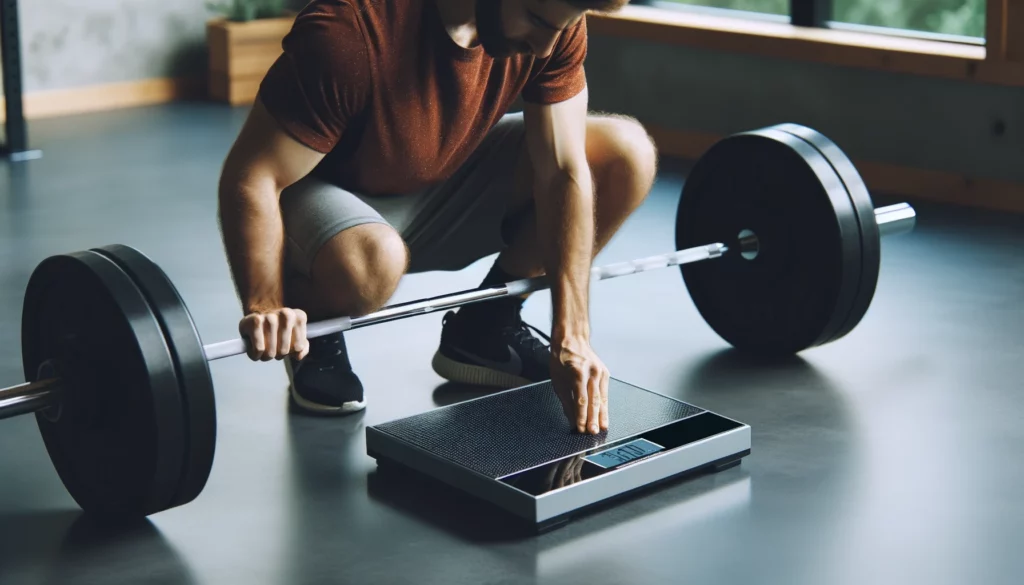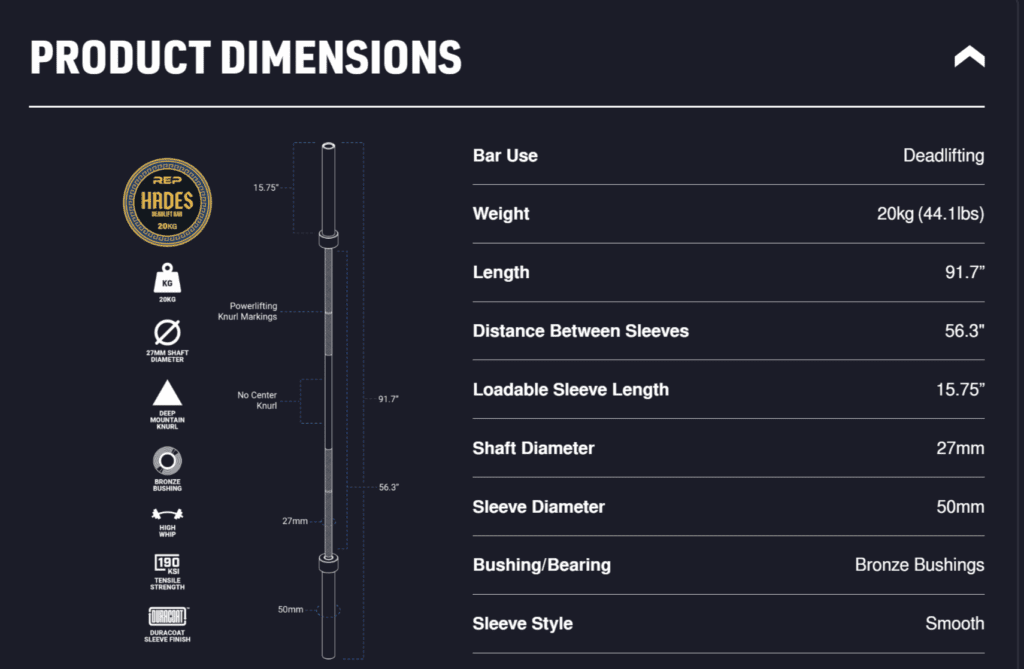Hello there! If you’re looking to build muscle, gain strength, and improve your lifting game, understanding deadlift bar weight is crucial.
This comprehensive guide will serve as your go-to resource for everything you need to know.
Let’s get started!
On This Page
Key Takeaways
| Question | Quick Answer |
| What is a Deadlift Bar? | A specialized barbell designed for deadlifting exercises. |
| Why Does Deadlift Bar Weight Matter? | The weight affects your lifting form, muscle engagement, and overall performance. |
| Standard Deadlift Bar Weight? | Typically around 45 pounds. |
| Specialty Deadlift Bars? | Trap bars, Hex bars, and Sumo bars are some examples. |
| How to Choose the Right Deadlift Bar? | Consider factors like your lifting experience, training goals, and the type of deadlift you’re performing. |
What is a Deadlift Bar?
A deadlift bar is a specialized type of barbell designed explicitly for performing deadlifts, one of the most effective strength training exercises.
Unlike standard barbells, deadlift bars are more flexible, allowing for a slight bend as you initiate the lift.
This flexibility provides a mechanical advantage, helping you lift heavier weights.
The bars often have a smaller diameter, making them easier to grip, which is crucial for deadlifting heavy weights.
The knurling on a deadlift bar is usually more aggressive to offer a better grip.
These bars are also typically longer than standard barbells, allowing for more bend and, consequently, the ability to lift heavier weights.
The unique features of a deadlift bar align with the mechanics of the exercise, ensuring optimal muscle engagement and making it a versatile addition to your home gym or regular gym setup.
Types of Bars Used for Deadlifts
| Type of Bar | Description | Weight | Length | Special Features |
| Standard Deadlift Bar | Most commonly used for deadlifts. Versatile but lacks specialized features. | 45 lbs | 7 ft | None |
| Olympic Deadlift Bar | Similar to standard but with rotating sleeves to reduce torque on wrists and forearms. | 45 lbs | 7 ft | Rotating Sleeves |
| Texas Deadlift Bar | Known for extreme flexibility and more aggressive knurling. Favored by powerlifters. | Varies | > 7 ft | Aggressive Knurling, Flexible |
| Ohio Deadlift Bar | Shorter and stiffer than the Texas bar but offers good flexibility and grip. | Varies | < 7 ft | Good Grip, Some Flexibility |
| Okie Deadlift Bar | Similar to Texas and Ohio bars but incredibly durable. | Varies | Varies | Durable |
| Trap Bar (Hex Bar) | This bar allows for a more upright posture. Good for those with back issues. | Varies | Varies | Hexagonal Shape |
| Sumo Deadlift Bar | Designed for sumo deadlifts. Generally the same weight as a standard bar but may have different knurling. | 45 lbs | 7 ft | Different Knurling or Grip Spacing |
| Powerlifting Deadlift Bar | Built to the specifications of powerlifting federations. May have center knurling and more aggressive grip patterns. | Varies | Varies | Center Knurling, Aggressive Grip |
Deadlift Bar Weight Comparison
So you’re in the market for a deadlift bar, but with so many options, how do you choose?
One way to narrow down your choices is by comparing the weights of different types of deadlift bars.
Below is a handy table that lists the top deadlift bars along with their respective weights.
| Barbell | Weight |
| Rogue Deadlift Bar | 20kg (44lbs) |
| Texas Deadlift Bar | 20kg (44lbs) |
| Titan Deadlift Bar | 20kg (44lbs) |
| Bells Of Steel Conventional Deadlift Bar | 20kg (44lbs) |
| Bells Of Steel Sumo Deadlift Bar | 20kg (44lbs) |
| Valor Fitness Deadlift Bar | 20kg (44lbs) |
As you can see, there is literally no difference in weight between all of the major Deadlift bars out there.
When in doubt, the bar is 45 lbs. Simple.
RELATED – Rogue Ohio Deadlift Bar vs Texas Deadlift Bar – One Bar To Rule Them All!
How to Choose the Right Deadlift Bar
Choosing the right deadlift bar is like choosing the right pair of running shoes; it can make or break your performance.
But with so many options out there, how do you decide? Let’s explore the factors you should consider.
Factors to Consider
- Your Lifting Goals – Are you lifting for general fitness, or are you training for a competition? Your goals will dictate the type of bar you need.
Type of Deadlift – Whether you’re doing conventional, sumo, or any other variation, the type of deadlift you prefer will influence your bar choice. - Grip and Hand Size – Smaller hands might benefit from a bar with a smaller diameter, while those with larger hands might prefer a thicker bar.
- Bar Flexibility – Some bars are more flexible than others, which can be beneficial for specific lifting styles.
- Budget – Specialty bars can be more expensive than standard bars, so consider how much you’re willing to invest.
- Space – Make sure you have enough room in your home gym for the bar you choose, especially if you’re considering a longer specialty bar.
How To Check Your Deadlift Bar Weight
So you’ve got a deadlift bar, but how do you know it weighs as much as it claims to?
Whether you’re skeptical or just curious, there are a couple of ways to check the weight of your deadlift bar.
Let’s get into it.
Using a Scale

The most straightforward method is to use a scale. Simply place the bar on a reliable scale and read the weight.
Make sure the scale is calibrated and can handle the weight of the bar.
This method gives you a direct measurement and can be particularly useful if you suspect your bar might not be up to standard.
Manufacturer’s Specifications

Another way to check the weight is to consult the manufacturer’s specifications.
This information is usually available on the manufacturer’s website or sometimes even imprinted on the bar itself.
While this method relies on the manufacturer’s honesty, it’s a quick way to get an idea of your bar’s weight without having to lift it onto a scale.
Deadlift Loaded Bar Weight Calculator
Total Loaded Bar Weight:
If you want to learn how to do it manually, check out my guide here.
Deadlift Bar vs Stiff Bar
Ah, the age-old debate: deadlift bar vs stiff bar. Both have their merits, but which one is better for you?
Let's weigh the pros and cons.
- Deadlift Bar - These bars are more flexible, allowing for more "whip" at the bottom of the lift, which can help you lift heavier weights. They often have more aggressive knurling for a better grip.
- Stiff Bar - Also known as a "power bar," these are rigid and don't have the same whip as a deadlift bar. They're versatile and can be used for other lifts like squats and bench presses.
- Which Is Better? - It really depends on your lifting goals. If you're focusing solely on deadlifting and aiming for maximum weight, a deadlift bar might be your best bet. If you're looking for a more versatile option for various lifts, a stiff bar could be the way to go.
Check out my deadlift bar vs stiff bar guide if you want to learn more!
Conclusion
Well, there you have it, folks—the ultimate guide to understanding deadlift bar weight.
We've covered everything from the types of bars and their weights to how to choose the right one for you.
Remember, the right bar can make a world of difference in your lifting experience.
So take the time to consider your options, check the weight, and most importantly, lift safely.
Until next time,
-Dante